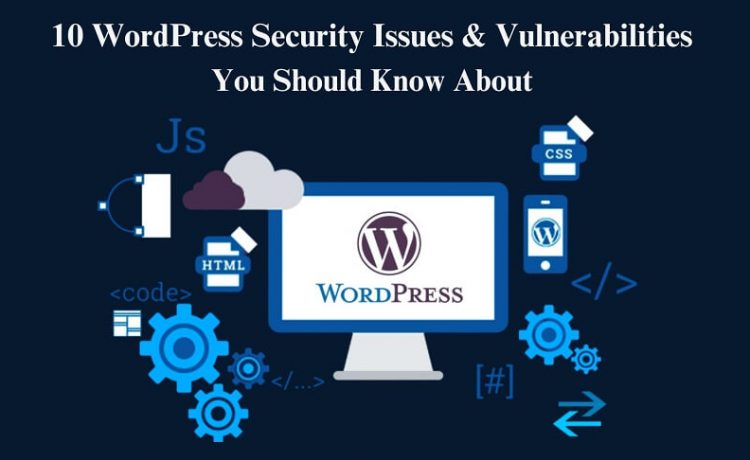10 WordPress Security Issues & Vulnerabilities You Should Know About

WordPress is a fantastic platform that powers millions of websites, but with great power comes great responsibility, right? Security should be on your list whether you have just finished a WordPress Course or are already managing a site. If you are running a blog, an online shop, or any website, keeping it secure is essential. But What is WordPress at its core? It’s an open-source platform, which makes it incredibly flexible and exposes it to specific vulnerabilities.
Let’s discuss ten key issues and vulnerabilities every WordPress site owner should know about.
Common Security Issues & Vulnerabilities of WordPress
Understanding these vulnerabilities will enable you to use proactive measures to secure your WordPress site efficiently.
1. Weak Passwords
One of the easiest ways hackers can access your site is through weak passwords. Creating solid and distinctive passwords is essential. Consider phrases or a combination of letters, numbers, and symbols. A password manager can create and securely store complex passwords, making it easier to maintain strong credentials.
2. Outdated Software
WordPress releases updates to enhance security and rectify problems. Failure to update your WordPress core, themes, and plugins can cause severe risks to your websites. Cybercriminals target outdated software versions, maintaining modern technology. Regularly check for changes and implement them without delay. Additionally, consider enabling automatic updates to ensure your site is always running the latest version.
3. Outdated Themes and Plugins
Not all themes and plugins are of similar quality. Some can contain malicious code or vulnerabilities that hackers can exploit. Use credible sources for your downloads, such as the official WordPress repository. Assess your installed plugins and remove unused ones. Examining views and verifying updates for any theme or plugin you want to install is essential to ensuring the developer actively maintains it.
4. SQL Injection
SQL injection is a standard strategy hackers use to exploit your database and obtain confidential information. They identify weaknesses in your code to obtain user information or seize control of your website. To reduce this risk, use safe coding methodologies and ensure your software is regularly updated. To mitigate the danger of this attack, regularly evaluate your database queries and authenticate user inputs.
5. Cross-Site Scripting or XSS
Hackers inject malicious code into your website via input forms, taking user information, including login credentials or personal data. To address this issue, verify that your plugins and themes originate from reputable developers and authenticate user input. Implementing Content Security Policy (CSP) headers can limit the sources from which scripts can be executed on your site.
6. File Permissions
Poor file permissions could lead to vulnerabilities on your website and enable attackers to access your website illegally. Ensure your file rights are set appropriately; files should usually be set to 644 and directories to 755. This helps keep unauthorized users at bay. Consistently evaluate your file permissions to ensure they remain unaltered and comply with the best security practices.
7. Lack of SSL Certificate
An SSL certificate encrypts data sent between your website and its users, ensuring a safe connection. Without it, malicious actors can intercept sensitive information, putting your visitors at risk. Prioritize the acquisition of an SSL certificate to safeguard your site. Many hosting companies provide this option, representing a small investment in insurance. Visitors are more inclined to trust a website with SSL, enhancing your trustworthiness.
8. Unsecured Login Pages
The login page is a primary target for attackers, necessitating robust security measures. Employ strategies such as restricting login attempts and utilizing two-factor authentication to safeguard against brute force attacks. This enhances security, complicating unauthorized access for hackers. Consider using a plug that tracks login activity and notifies you of anomalous conduct.
9. Poor Backup Practices
Not having a reliable backup strategy can result in catastrophic effects such as a hacking incident or system breakdown. A backup reduces downtime and data loss and allows for quick site restoration. Use WordPress backup plugins or services that systematically automate backups to ensure you are always prepared. Additionally, maintain backups in many places, including cloud storage and a local disc, to enhance security.
10. Ignoring User Roles and Permissions
If multiple users are on your site, managing their roles and permissions wisely is essential. Grant users the necessary access required for their specific roles, enabling them to engage in activities pertinent to their responsibilities. This reduces possible harm in the event of an account breach. Regularly evaluate user rights and revoke access for those who no longer need it, ensuring a safe environment.
Conclusion
Staying informed about WordPress security issues is essential for any website owner. Understanding these vulnerabilities and problems can help protect your site from potential threats. If you want to deepen your knowledge on this topic, The Knowledge Academy offers free resources that can guide you through effectively securing your WordPress site.
